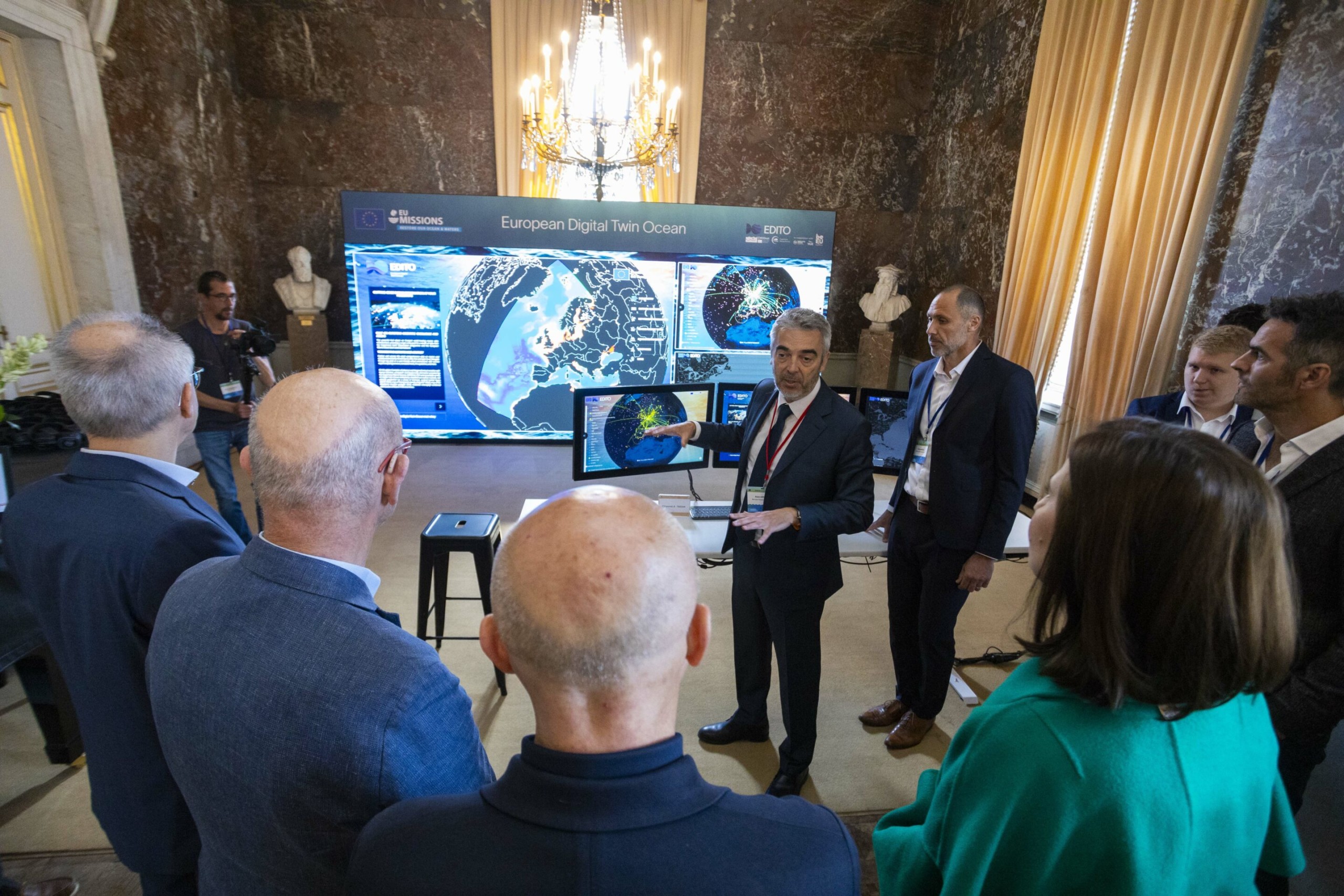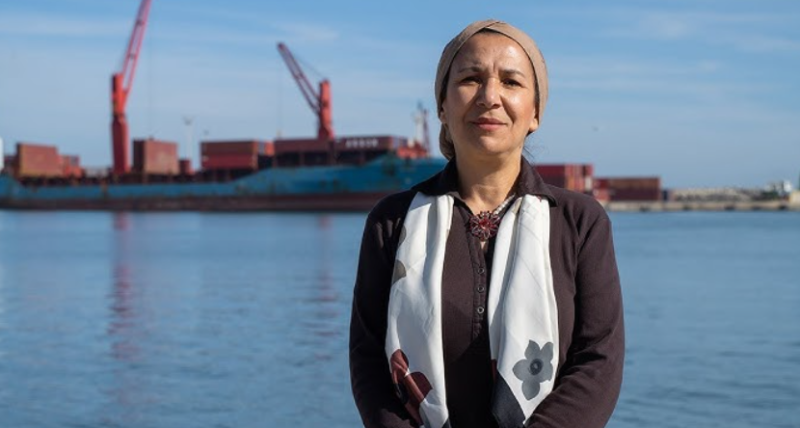This event, a key milestone in the EU’s « Restoring Our Oceans and Waters » mission calendar, brought together a wide range of climate/environment and policy stakeholders, including senior representatives from five Directorates-General (DGs) of the European Commission.
The forum, organized by the Directorate-General for Research and Innovation (DG RTD), the Directorate-General for Maritime Affairs and Fisheries (DG MARE), and the Directorate-General for Defence Industry and Space (DG DEFIS), with support from Mercator Ocean International and the Flanders Marine Institute (VLIZ), prominently unveiled the new European Digital Twin Ocean (EU DTO), a groundbreaking initiative aimed at transforming marine data accessibility by integrating new and existing resources to assist policymakers in planning for the oceans of tomorrow.
High-Level Intervention featuring Iliana Ivanova, European Commissioner for Innovation, Research, Culture, Education, and Youth.
During a live private demonstration of the EU DTO platform, Iliana Ivanova, European Commissioner for Innovation, Research, Culture, Education, and Youth, along with key stakeholders, observed data on marine plastic waste tracking, revealing significant plastic debris in the sea originating from European countries.
The visualization had a profound impact on the European official, who emphasized that countries had « work to do » in combating pollution. « The Digital Twin Ocean is truly extraordinary and unprecedented, » she told journalists at the event. With this new platform, national authorities could now be held accountable for their polluting actions.
« It will help us understand how pollution and human activities affect the ocean and its crucial role in climate regulation and biodiversity preservation. It’s still a prototype, but once fully operational, the platform will be a game-changer in ocean management, » she said.
Pierre Bahurel, Director-General of Mercator Ocean International (MOi), led demonstrations of the brand-new pre-operational EU DTO platform before a gathering of dignitaries, stakeholders, and future EU DTO users.
« The platform represents a revolutionary initiative, providing an advanced digital model of the ocean that integrates real-time data and simulations. This tool is crucial for enhancing our understanding of marine environments and supporting sustainable ocean management, » Mercator’s director told distinguished guests.
The event also attracted several key personalities from European institutions, including European Commissioner Florika Fink-Hooijer (DG ENV) and Thomas Skordas, Deputy Director-General of DG CNECT.
Expected to be fully operational by 2025, this platform combines data and services from the flagship European Copernicus Marine Service (implemented by MOi) and EMODnet, along with other providers, into a comprehensive digital framework. By integrating artificial intelligence (AI) and high-performance computing, the EU DTO aims to revolutionize oceanographic models, providing new tools for ocean adaptation and mitigation, sustainable ocean resource management, and blue economic development.
This new platform opens myriad new possibilities for policymakers, allowing users worldwide to execute significant hypothetical scenarios. Through the EU DTO tool, users can contribute to mapping and visualizing the impact of decisions on biodiversity, coastal protection, marine protected areas, as well as the impacts of inaction.
The forum underscored the EU’s commitment to environmental protection and innovation, aligning with the EU Green Deal, digital strategy, and the United Nations Decade of Ocean Science for Sustainable Development. Participants, including key figures like John Bell, Director of Healthy Planet at DG RTD, and Kestutis Sadauskas, Deputy Director-General for Maritime Affairs and Fisheries (DG MARE), witnessed demonstrations of the EU DTO’s capabilities in managing marine litter, biodiversity conservation, renewable energies, early warning systems, and coastal monitoring.
Bell highlighted the transformative potential of the Digital Twin Ocean: « Our understanding of the ocean is crucial for our future as a society and economy, » he told conference attendees. « The Digital Twin Ocean will revolutionize our interaction with the ocean, offering a comprehensive way to understand and predict its dynamics. »
From coastal activities planning to ecosystem management, the EU official said the new proposed tool would be essential for decision-making to prepare for « extreme weather events » and « aquaculture opportunities. »
The importance of the EU DTO becomes even more evident when considering the challenges facing the world’s oceans today. According to the European Environment Agency, marine ecosystems are under significant pressure from pollution, overfishing, and climate change. The EU DTO could be leveraged to address several marine challenges Europe faces, including Baltic Sea eutrophication or overfishing in the Mediterranean Sea.
Alain Arnaud (Director of Digital Ocean, Mercator Ocean International) explains to stakeholders, including Commissioner Ivanova and John Bell, Director of Healthy Planet RTD, how the EU DTO tool enables sophisticated hypothetical scenario implementations. © Bernal Revert/BR&U.
Marine litter, especially plastics, has become a global crisis. Scientists estimate that in 2021, 75 to 200 million tonnes of plastics were in the oceans, with Europe contributing significantly. Plastic pollution not only affects marine life but also enters the food chain, posing risks to human health. The EU DTO provides a platform for policymakers to assess the best ways to protect oceans from human activity.
The EU DTO is a collaborative effort involving stakeholders from both private and public sectors. Over 70 EU-funded projects were represented at a previous scientific and technical workshop on the EU DTO, aimed at gathering feedback and setting priorities for future developments.
The digital twin, explained Sadauskas, Deputy Director-General of DG MARE, is a prime example of stakeholder engagement and capacity to collaborate on broad climate goals.
« The goal was to build a necessary base and interface to bring together everything we know about the ocean, » he explained in his address. « This base will allow the marine community to build on this knowledge and create bespoke applications that capture the details of our coastal and marine ecosystems. »
« For me, the real value in embarking on the development of the EU digital twin lies truly in creating this community that works together towards the common goal of describing and understanding the ocean, its biodiversity, and most importantly, its interactions with us, our societies, economies, and lifestyles, » he said.
Harnessing New Technologies
The digital copy of the ocean brings together a variety of existing sources and consolidates them into a convenient, interactive platform. A significant player in the EU DTO platform is the European Marine Observation and Data Network (EMODnet), a leading in-situ marine data service managed by the EU with data from various European institutions, and the Copernicus Marine Service, which provides satellite, in-situ, and numerical model services for visualizing the ocean in the past, present (almost real-time), and future (forecasts) from the surface to depth across blue (physical), white (sea ice), and green (biogeochemical and biological) oceans.
Kestutis Sadauskas, Deputy Director-General for Maritime Affairs and Fisheries (DG MARE), unveiling the European prototype of the digital twin ocean.
Sadauskas praised EMODnet: « Without EMODnet, the Digital Twin Ocean would not be possible. It plays a crucial role in ensuring diverse marine data is harmonized and accessible. » This integration of different platforms will be valuable in supporting the broader EU mission to integrate high-performance computing and AI in ocean research through the EU’s seven-year Horizon Europe research initiative.
Other data sources, such as the EU’s flagship Earth observation program, Copernicus, bring powerful data, infrastructures, and services to the new EU DTO platform through its Copernicus Marine Service. In a speech at the Digital Ocean Forum, Mauro Facchini, Head of the Defence Industry and Space Unit (DG DEFIS), highlighted the power behind these services. The Copernicus program, under Facchini’s DG, relies on a wide array of satellites and supercomputers, now integrated into the marine platform.
« High-performance computing plays a key role in the digital twin, » he explained. « We hope that by providing cross-sectional data worldwide, we can bring additional capabilities and reduce the time needed for reporting. »
Mauro Facchini, Head of the Defence Industry and Space Unit (DG DEFIS). © Bernal Revert/BRU.
By combining these powerful data sources and services, ordinary users of the platform will soon be able to run powerful simulations leveraging numerous data sources.




